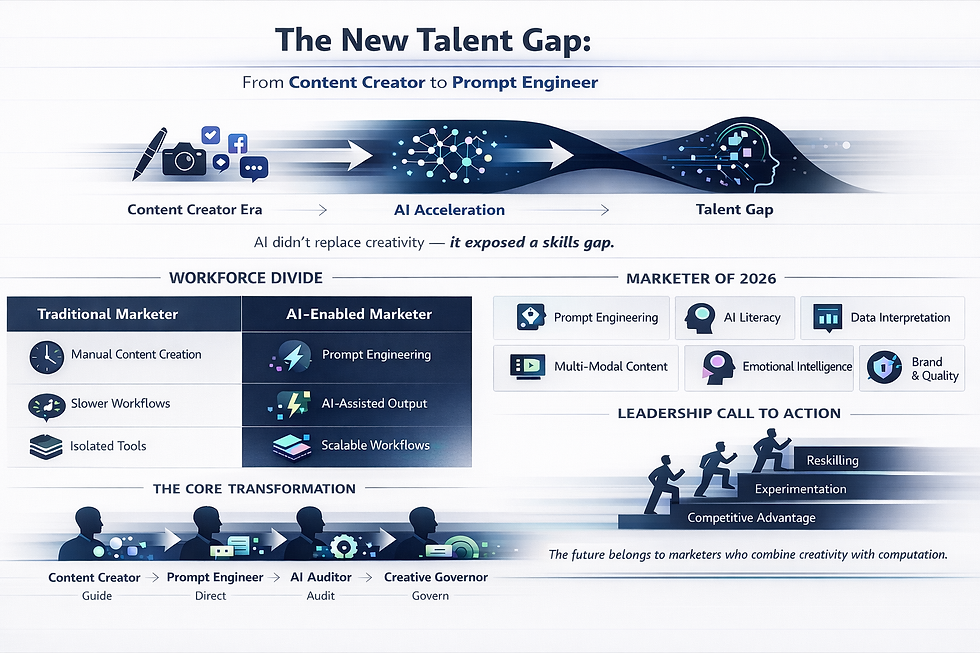Igniting the Spark: How to Cultivate a Culture of Innovation in Marketing Teams
- Angel Francesca
- Dec 24, 2024
- 4 min read
The marketing landscape is changing faster than ever. To capture audience attention and drive results, your team needs to be a powerhouse of innovation.

This blog reveals how to cultivate a culture of creativity, unlock your team's potential, and achieve groundbreaking success.
Why Innovation is Crucial for Marketing Success
Innovation in marketing goes beyond simply creating eye-catching campaigns. It's about:
Differentiation: In a crowded marketplace, innovation allows brands to stand out and capture audience attention.
Adaptability: Innovative teams are more agile and better equipped to respond to market shifts, emerging technologies, and evolving consumer behaviours.
Customer Engagement: By embracing new ideas and exploring creative solutions, marketing teams can deliver more engaging and impactful experiences for their target audience.
Growth: Innovation fuels growth by enabling companies to anticipate trends, identify new opportunities, and create value that resonates with their customers.
Strategies to Inspire Innovation in Your Marketing Team
Cultivate a Culture of Curiosity and Experimentation:
Embrace Failure: Create a safe space where team members feel comfortable taking risks and experimenting without the fear of failure. Encourage learning from mistakes, viewing them as valuable opportunities for growth.
Celebrate Ideas: Foster an environment where all ideas are welcomed and celebrated, regardless of their initial feasibility. Regular brainstorming sessions and open dialogues can stimulate creative thinking and encourage team members to share their thoughts freely.
Encourage Cross-Functional Collaboration: Break down silos and encourage collaboration between marketing and other departments like sales, product development, and customer service. Diverse perspectives can spark new ideas and lead to innovative solutions.
Example: Airbnb encourages cross-functional thinking, bringing together teams from different departments to brainstorm new ideas and solve problems, fostering a collaborative environment that fuels innovation.
Provide the Right Tools and Resources:
Invest in Technology: Equip your team with the tools they need to be creative and productive, such as design software, data analytics platforms, and project management tools.
Access to Learning Opportunities: Offer opportunities for professional development, including workshops, conferences, and online courses, to keep your team up-to-date on the latest trends and technologies.
Example: HubSpot invests in its employees by providing access to online courses and training, fostering an innovative mindset and enabling them to apply new skills and strategies to their marketing efforts.
Time for Exploration: Allocate dedicated time for team members to explore new ideas, experiment with different approaches, and learn from their experiences. Google's famous "20% time" policy, which allows employees to dedicate a portion of their work time to passion projects, has led to innovative products like Gmail and Google News.
Lead by Example:
Be a Champion of Innovation: As a leader, demonstrate your own commitment to innovation by actively seeking out new ideas, embracing change, and encouraging experimentation within your team.
Recognise and Reward Innovation: Acknowledge and celebrate innovative ideas and successful projects. Rewards and recognition can motivate the team and reinforce the importance of creativity.
Example: Zappos celebrates employee creativity and innovation by regularly highlighting innovative ideas from its staff, creating a sense of pride and encouraging further contributions.
Make Space for Play and Inspiration:
Unplug and Recharge: Encourage your team to take breaks, unplug from technology, and engage in activities that spark creativity and inspire new ideas.
Bring in External Inspiration: Invite guest speakers, industry experts, or creative professionals to share their insights and inspire your team.
Create a Creative Workspace: Design a workspace that fosters collaboration, creativity, and inspiration, with comfortable seating, natural light, and stimulating artwork.
Leverage Technology and Data:
Embrace Marketing Technologies: Utilise marketing automation, artificial intelligence, and data analytics to gain deeper insights into customer behaviour and optimise campaigns.
Example: Netflix leverages data analytics to understand viewer preferences, personalize recommendations, and create original content that resonates with its audience, driving significant subscriber growth.
Data-Driven Decision Making: Encourage data-driven decision-making and experimentation with data-driven strategies to identify new opportunities for innovation.
Set Innovation Goals:
Establish clear goals and metrics related to innovation to focus your team's efforts and track progress. These goals could include developing a certain number of new campaign ideas each quarter or experimenting with emerging technologies.
Example: Unilever sets ambitious sustainability goals that inspire its marketing teams to innovate in product development and messaging, strengthening brand loyalty among environmentally conscious consumers.
Real-World Examples of Marketing Innovation
Coca-Cola's Freestyle Machines: Coca-Cola's Freestyle vending machines allow customers to create custom beverage mixes, providing a unique customer experience and generating valuable data on consumer preferences.
IBM's Innovation Jams: IBM conducts global "Innovation Jams" — large-scale virtual brainstorming sessions involving employees, partners, and clients — to generate innovative ideas and solutions, fostering a culture of collaboration and creativity.
Conclusion
Inspiring innovation within your marketing team is an ongoing process that requires a strategic approach, a supportive environment, and a commitment to fostering a culture of creativity and experimentation. By embracing these principles, you can unlock the potential of your team, drive creative solutions, and stay ahead of the curve in the ever-evolving marketing landscape. Remember, innovation is not just about generating ideas; it's about creating value, making a meaningful impact, and achieving remarkable results.
Call-to-Action
For anyone that wants any further guidance, ClickAcademy Asia is exactly what you need. Join our class in Singapore and enjoy up to 70% government funding. Our courses are also Skills Future Credit Claimable and UTAP, PSEA and SFEC approved. Find out more information and sign up here. (https://www.clickacademyasia.com/fast-track-marketing-leadership).


Comments